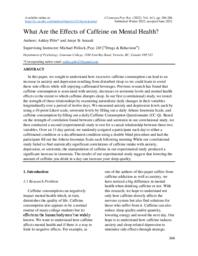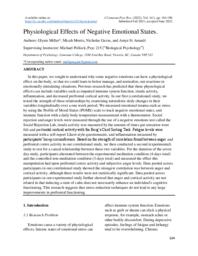Amye St Arnault
Person Preferred Name
(none provided) (none provided)
Related Works
Content type
Digital Document
Description / Synopsis
In this paper, we sought to understand how excessive caffeine consumption can lead to an increase in anxiety and depression resulting from disturbed sleep so we could learn to avoid these side effects while still enjoying caffeinated beverages. Previous research has found that caffeine consumption is associated with anxiety, decreases in serotonin levels and mental health effects to the extent to which caffeine disrupts sleep. In our first (correlational) study, we tested the strength of these relationships by examining naturalistic daily changes in their variables longitudinally over a period of twelve days. We measured anxiety and depression levels each by using a 10-point Likert scale, serotonin levels by filling out a daily Athens Insomnia Scale, and caffeine consumption by filling out a daily Caffeine Consumption Questionnaire (CC-Q). Based on the strength of correlation found between caffeine and serotonin in our correlational study, we then conducted a second (experimental) study to test for a causal relationship between these two variables. Over an 11-day period, we randomly assigned a participant each day to either a caffeinated condition or a decaffeinated condition using a double blind procedure and had the participant fill out the Athens Insomnia Scale each following morning While our correlational study failed to find statistically significant correlations of caffeine intake with anxiety, depression, or serotonin, the manipulation of caffeine in our experimental study produced a significant increase in insomnia. The results of our experimental study suggest that lowering the amount of caffeine you drink in a day can increase your sleep quality.
Origin Information
Content type
Digital Document
Description / Synopsis
In this paper, we sought to understand why some negative emotions can have a physiological effect on the body, so that we could learn to better manage, and normalize, our reactions in emotionally stimulating situations. Previous research has predicted that these physiological effects can include variables such as impaired immune system function, insula activity, inflammation, and decreased prefrontal cortical activity. In our first (correlational) study, we tested the strength of these relationships by examining naturalistic daily changes in their variables longitudinally over a one week period. We measured emotional trauma such as stress by using the Profile of Mood States (POMS) scale to track negative emotional states, and immune function with a daily body temperature measurement with a thermometer. Social rejection and anger levels were measured through the use of a negative emotions test called the Social Rejection Lab, insula activity was measured by the amount of times gut sensation were felt and prefrontal cortical activity with the Berg’s Card Sorting Task. Fatigue levels were measured with a self-report Likert-style questionnaire, and inflammation measured by participants’ bicep circumference. Based on the strength of correlation found between anger and prefrontal cortex activity in our correlational study, we then conducted a second (experimental) study to test for a causal relationship between these two variables. For the duration of the seven day study, participants alternated between the experimental meditation condition (4-days total) and the controlled non-meditation condition (3-days total) and measured the effect this manipulation had upon prefrontal cortex activity and subjective anger levels. Data pooled across participants in our correlational study showed the strongest correlation was between anger and cortical activity, although these results were not statistically significant. Data pooled across participants in our experimental study further showed that anger and cortical activity are not related in that inducing a state of calm does not necessarily enhance an individual's cognitive functioning. This research suggests that stress-reduction techniques do not lead to any large improvements in prefrontal functioning.
Origin Information

